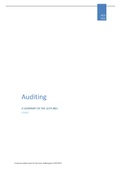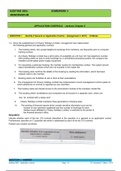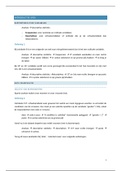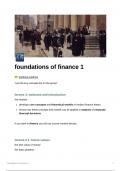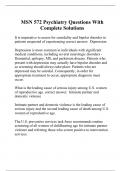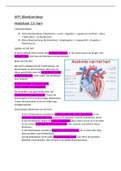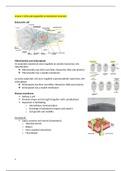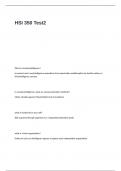2022
Auditing
A SUMMARY OF THE LECTURES
LOUIST
A summary made by LouisT for the course: Auditing given in 2021/2022
,Contents
Chapter 1. Introduction to the course ................................................................................................... 4
1.1 Assurance ................................................................................................................................ 4
1.1.1 Audits .............................................................................................................................. 4
1.1.2 The objective of an audit ................................................................................................ 5
1.1.3 Audit vs Assurance .......................................................................................................... 5
1.2 Financial Statement Audits .................................................................................................... 5
1.3 Modern Auditing..................................................................................................................... 6
1.4 Paper: Real effects of the audit choice by Kausar, Shroff, and White (2016) ...................... 6
1.4.1 Relevance of the paper ................................................................................................... 6
1.4.2 Hypothesis Development ............................................................................................... 7
1.4.3 Setting ............................................................................................................................. 7
1.4.4 Data ................................................................................................................................. 7
1.4.5 Results ............................................................................................................................. 9
1.4.6 Conclusions ................................................................................................................... 12
1.5 Q&A ....................................................................................................................................... 12
1.5.1 Company: Theranos ...................................................................................................... 14
Chapter 2. The Basics of Auditing and auditing circumstances........................................................... 15
2.1 Audit Market Development ................................................................................................. 15
2.1.1 Reforms ......................................................................................................................... 15
2.1.2 Other issues................................................................................................................... 15
2.2 The Fundamental Principles (IESBA Code of Ethics) ............................................................ 16
2.3 Materiality ............................................................................................................................ 16
2.4 Reasonable Assurance .......................................................................................................... 16
2.5 Professional Judgment and Skepticism................................................................................ 16
2.6 Audit Phases.......................................................................................................................... 16
2.7 Paper: Shredded Reputation The cost of Audit Failure by Chaney and Philipich (2002) ... 17
2.7.1 History ........................................................................................................................... 17
2.7.2 Research ........................................................................................................................ 18
2.7.3 Hypotheses.................................................................................................................... 19
2.7.4 Sample & Research Method ......................................................................................... 19
2.7.5 Results ........................................................................................................................... 19
2.7.6 Conclusions ................................................................................................................... 21
2.8 Paper: The effect of audit market structure on audit quality and audit pricing in the
private-client market by Van Raak et al. (2020) .............................................................................. 21
2.8.1 Motivating Question ..................................................................................................... 22
A summary made by LouisT for the course: Auditing given in 2021/2022
, 2.8.1 Viewpoints .................................................................................................................... 22
2.8.2 Hypotheses.................................................................................................................... 22
2.8.3 Sample ........................................................................................................................... 23
2.8.4 Audit Market Structure ................................................................................................ 23
2.8.5 Descriptive Statistics ..................................................................................................... 24
2.8.6 Results ........................................................................................................................... 25
2.8.7 Conclusions ................................................................................................................... 26
2.9 Q&A ....................................................................................................................................... 26
Chapter 3. Client Acceptance & Fraud ................................................................................................. 29
3.1 Recap ..................................................................................................................................... 29
3.2 Client Acceptance ................................................................................................................. 29
3.2.1 Engagement Letter........................................................................................................ 29
3.2.2 Relevant Factors ........................................................................................................... 29
3.2.3 Independence ............................................................................................................... 29
3.3 Fraud ..................................................................................................................................... 30
3.3.1 Categories of Fraud ....................................................................................................... 30
3.3.2 Illustrations ................................................................................................................... 30
3.3.3 Backbone of Fraud ........................................................................................................ 31
3.3.4 ISA420............................................................................................................................ 31
3.4 Q&A ....................................................................................................................................... 31
3.4.1 Trompeter et al. AJPT (2013) ........................................................................................ 36
3.4.2 Worldcom...................................................................................................................... 37
Chapter 4. Audit Planning..................................................................................................................... 38
4.1 Audit Planning....................................................................................................................... 38
4.1.1 Benefits of audit planning ............................................................................................ 38
4.1.2 Goals of audit planning ................................................................................................. 38
4.2 Materiality ............................................................................................................................ 38
4.2.1 Assessing Materiality (Quantitative)............................................................................ 38
4.2.2 Assessing Materiality (Qualitative) .............................................................................. 39
4.2.3 Performance Materiality .............................................................................................. 39
4.3 Audit Risk Model................................................................................................................... 40
4.4 Paper: Misstatements in Financial Statements: The Relationship between Inherent and
Control Risk Factors and Audit Adjustments by Ruhnke & Schmidt (2014) ................................... 41
4.4.1 Relevance ...................................................................................................................... 41
4.4.2 Methodology................................................................................................................. 42
4.4.3 Results ........................................................................................................................... 43
A summary made by LouisT for the course: Auditing given in 2021/2022
, 4.4.4 Conclusion ..................................................................................................................... 44
4.5 Paper: Do Auditors Recognize the Potential Dark Side of Executives’ Accounting
Competence? By Albrecht et al. (2018) ........................................................................................... 44
4.5.1 Relevance ...................................................................................................................... 44
4.5.2 Hypothesis Development ............................................................................................. 44
4.5.3 Methodology................................................................................................................. 45
4.5.4 Results ........................................................................................................................... 46
4.5.5 Conclusions ................................................................................................................... 47
4.6 Q&A ....................................................................................................................................... 48
Chapter 5. Assertions............................................................................................................................ 51
5.1 Management’s Financial Statement Assertions .................................................................. 51
5.1.1 Management Assertions about financial statements ................................................. 51
5.2 Conceptual Model of the Audit Process .............................................................................. 52
5.2.1 Audit Procedures to obtain audit evidence ................................................................. 52
5.2.2 Types of Audit Procedures............................................................................................ 52
5.2.3 Examination of documents: Vouching and Tracing ..................................................... 53
5.2.4 Quality of Audit Evidence ............................................................................................. 53
5.2.5 Relationship Materiality – Risk - Evidence................................................................... 53
5.3 Paper: Materiality Judgments and the Resolution of Detected Misstatements: The role of
Managers, Auditors, and Audit Committees by Keune & Johnstone (2012) .................................. 54
5.3.1 Conceptual Model ......................................................................................................... 54
5.3.2 Hypothesis Development ............................................................................................. 55
5.3.3 Data & Methodology .................................................................................................... 55
5.3.3 Results ........................................................................................................................... 56
5.3.4 Additional Analyses ...................................................................................................... 56
5.3.5 Conclusions ................................................................................................................... 56
5.4 Paper: Audit Quality by Knechel et al. (2013)...................................................................... 56
5.4.1 Importance of audit quality.......................................................................................... 57
5.4.2 What makes an audit a good audit? ............................................................................ 57
5.4.3 Definitions of Audit Quality .......................................................................................... 58
5.4.3 Indicators of Audit Quality ........................................................................................... 58
5.4.4 The Paper ...................................................................................................................... 59
5.4.5 Key Interactions ............................................................................................................ 61
5.4.6 Contextual Factors (IAASB / Knechel et al.) ................................................................. 61
5.4.7 Conclusions ................................................................................................................... 62
5.5 Q&A ....................................................................................................................................... 62
A summary made by LouisT for the course: Auditing given in 2021/2022
,Chapter 6. Audit Completion................................................................................................................ 66
6.1 The Final Test ........................................................................................................................ 66
6.1.1 Additional Tests ............................................................................................................ 66
6.1.2 Review for Contingent liability ..................................................................................... 67
6.1.3 Subsequent Event ......................................................................................................... 67
6.1.4 Final Evidence Accumulation ........................................................................................ 68
6.1.5 Evaluate the Results ..................................................................................................... 68
6.1.6 Issue Audit Report ........................................................................................................ 68
6.1.7 Communicate with the audit committee and management ....................................... 69
6.2 Key Audit Matters ................................................................................................................. 69
6.3 Types of Audit Opinions ....................................................................................................... 69
6.3.1 Unmodified audit report .............................................................................................. 69
6.3.2 Qualified audit report ................................................................................................... 69
6.3.3 Adverse Auditor’s Report ............................................................................................. 70
6.3.4 Denial/Disclaimer ......................................................................................................... 70
6.4 Pervasive ............................................................................................................................... 70
6.5 Going-Concern Opinion (ISA 570)......................................................................................... 70
6.6 Other issues .......................................................................................................................... 71
6.7 An Incomplete Audit at the Earnings Announcement: Implications for financial reporting
quality and the market’s Response to Earnings by Marshall et al. (2019) ..................................... 71
6.7.1 Relevance ...................................................................................................................... 71
6.7.2 Hypothesis Development ............................................................................................. 71
6.7.3 Methodology................................................................................................................. 72
6.7.4 Results ........................................................................................................................... 73
6.7.5 Conclusions ................................................................................................................... 74
A summary made by LouisT for the course: Auditing given in 2021/2022
,Chapter 1. Introduction to the course
Welcome to this summary. First, an introduction to this course. The objectives of this course are as
follows:
• Understand the economic role of statutory audits.
• Understand the main concepts underlying auditing.
• Understand the professional and regulatory requirements that guide the conduct of audits.
• Be familiar with audit theory and research
• Be familiar with contemporary developments.
For each article, you should know The research question, theories & hypothesis development, setting
& approach, main findings, conclusions, and implications. Each chapter will end with the Q&A
information of a certain week. Important course material discussed during the Q&A will be merged
with the recordings of the lectures.
1.1 Assurance
An assurance engagement in which a practitioner aims to obtain sufficient appropriate evidence to
express a conclusion designed to enhance the degree of confidence of the intended users other than
the responsible party about the subject matter information.
This means an engagement (auditor) obtains sufficient evidence to express a conclusion (to what
extent the financial statement give a true and fair view) to enhance the degree of confidence of the
intended users (such as shareholders) other than the responsible party (board, management board)
about the subject matter information (the financial statements). So audit is an example of an
assurance engagement.
1.1.1 Audits
So the whole circle consists of assurance services and within this, we have two types of services,
namely attestation services, and direct engagement.
Attestation services are always about the accountable party. Management board subject matter
using appropriate criteria. This is on paper and written by the client on how they are doing. So for
example, examining the financial statement. Direct engagement is practitioner measures or
evaluates the underlying subject matter against the applicable criteria.
Within attestation services, we have audits and reviews. The most important difference between
these two is that audits provide a high level of assurance and review a low level of assurance. Some
companies do not have the funds to have an audit, they could therefore choose to review. Then we
have internal control over financial reporting and attestation services on sustainability reporting,
information technology, etc.
4
A summary made by LouisT for the course: Auditing given in 2021/2022
, 1.1.2 The objective of an audit
The objective of an Audit can be described as follows:
1. The objective of an audit of the financial statements is, according to ISA 200 :
a. to obtain reasonable assurance about whether the financial statements as a whole
are free from material misstatement, whether due to fraud or error, thereby
enabling the auditor to express an opinion on whether the financial statements have
been prepared, in all material respects, in accordance with an applicable financial
reporting framework; and
b. to report on the financial statements and to communicate as required by the ISA’s in
accordance with the auditor's findings.
1.1.3 Audit vs Assurance
The audit is just a part of assurance. An audit engagement is an example of an assurance
engagement. Assurance engagements differentiate by subject matter, level of assurance, whether
they are historical or future based and whether they are assertion-based. Assurance engagements on
historical financial information are labeled as ‘audit’ and are aimed to obtain a reasonable level of
assurance. In all these situations it is important that the auditor or practitioner can apply professional
judgment and professional skepticism. A prerequisite for all assurance engagements is the availability
of suitable criteria.
1.2 Financial Statement Audits
To enhance the degree of confidence of intended users in the financial statements. This is achieved
by the expression of an opinion by the auditor on whether the financial statements are prepared, in
all material respects, in accordance with an applicable financial reporting framework. In the case of
most general-purpose frameworks, that opinion is on whether the financial statements are
presented fairly, in all material respects, or give a true and fair view in accordance with the
framework. An audit conducted in accordance with ISAs and relevant ethical requirements enables
the auditor to form that opinion.
Intended users are not only shareholders but also tax authorities, media, environmental groups, etc.
Applicable financial reporting framework → There could be different such as DUTCH GAAP, GAAP,
IFRS.
5
A summary made by LouisT for the course: Auditing given in 2021/2022


